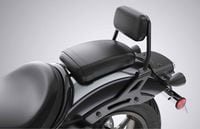The Honda Rebel family grows by one in 2021, with the Rebel 1100 joining the ranks as a full-size complement to its 500cc (read about it in the 2020 Honda Rebel 500 ABS MC Commute Review) and 300cc siblings. It will be available in dealerships starting January 2021 in DCT or standard manual transmission trims, pricing at $9,999 for DCT and $9,299 for manual.
The Rebel has long been known as the low-displacement, affordable, easy-to-ride bike that makes a great starter machine for new riders. Even after the heavy model revision three years ago, the Rebel remained perfectly suited to new (or newer) riders. Even so, it was clear that Honda had ambitions to reimagine its cruiser line more broadly. The new Rebels were designed to appeal to younger riders; to fit into an urban landscape filled with commuters and day-trippers. They weren’t smaller, raked-out versions of more traditionally styled cruisers or lightly altered versions of the previous Rebel design. They were Honda’s interpretation of what this new breed of rider wants from a relaxed, affordable, easy-to-ride motorcycle.
With this in mind, it’s surprising and refreshing to see Honda push its Rebel line into deeper waters. The new Rebel 1100 will be the largest ever produced, meaning it will be able to target an entirely new customer base. Riders with miles under their belts. Riders who want their bike to comfortably eat up long miles on the highway. Riders who want to live with a Rebel for the long term.
The Rebel 1100 is powered by a 1,084cc Unicam parallel-twin engine derived from the mill used in the Africa Twin. It features a 270-degree crank and different camshaft profiles for each cylinder. This is because Honda has designed one cylinder to provide more power below 4,000 rpm and the other to provide more power above 4,000 rpm. Biaxial counterbalancing elements smooth vibrations throughout the rev range.
Three different ride modes (Standard, Sport, and Rain) allow riders to dial engine output for different conditions, while a fourth will be rider programmable. It’s also equipped with ride-by-wire, cruise control, four levels of torque control, and three levels of wheelie control.
The DCT automatic transmission option will also have paddle shifters, giving riders the choice of moving through the six-speed gearbox via those shifters or relaxing back into the fully automatic mode. The manual transmission option will feature a slip/assist clutch for smoother downshifts and lighter clutch pull.
A steel trellis frame is suspended by a 43mm conventional fork and dual Showa shocks. It rolls on 18-inch front and 16-inch rear cast aluminum wheels and has a braking package that includes a 330mm disc, radial-mount four-piston caliper at the front, and a 256mm disc, single-piston caliper at the rear. ABS is standard.
Other amenities include an underseat USB port, lightweight lithium-ion battery, low 27.5-inch seat height, full LED lighting, and an LCD instrument display.
Honda also aims to give riders plenty of customization options from its accessories catalog. Among those will be a passenger seat assembly which includes bolt-on seat rails, passenger seat, and footpegs. Saddlebags, different seat colors, a windscreen, and backrest are among the other items riders will be able to easily bolt on.
As with previous Rebels, the low stance, narrow profile, and spacious rider triangle will give the 1100 broad appeal. Even the 487-pound curb weight (manual six-speed transmission option) is approachable, particularly considering the bulk of the bike’s mass is low to the ground and the design allows for a solid footing at stops.
And finally, styling is right in line with the Rebel 300 and Rebel 500. Much more of a sport-cruiser look, especially when compared against the other large-bore offerings in Honda’s cruiser line like the Shadow or Fury.
Honda has an interesting model on its hands with the Rebel 1100. It will be exciting to see how all the work put into the model translates on the road.

























/cloudfront-us-east-1.images.arcpublishing.com/octane/2WF3SCE3NFBQXLDNJM7KMXA45E.jpg)
/cloudfront-us-east-1.images.arcpublishing.com/octane/G4MG6OUCJNBSHIS2MVVOTPX65E.jpg)
/cloudfront-us-east-1.images.arcpublishing.com/octane/IIGGWFOTOJGB7DB6DGBXCCMTDY.jpg)
/cloudfront-us-east-1.images.arcpublishing.com/octane/QSTCM6AVEZA5JJBUXNIQ3DSOF4.jpg)
/cloudfront-us-east-1.images.arcpublishing.com/octane/U4I7G625B5DMLF2DVIJDFZVV6M.jpg)
/cloudfront-us-east-1.images.arcpublishing.com/octane/B6XD6LS6IVCQPIU6HXDJSM3FHY.jpg)
/cloudfront-us-east-1.images.arcpublishing.com/octane/ICL63FEDDRDTTMINYICCEYGMDA.jpg)
/cloudfront-us-east-1.images.arcpublishing.com/octane/FCGZHQXRBZFLBAPC5SDIQLVF4I.jpg)
/cloudfront-us-east-1.images.arcpublishing.com/octane/WNOB6LDOIFFHJKPSVIWDYUGOPM.jpg)

/cloudfront-us-east-1.images.arcpublishing.com/octane/X33NU3E525ECRHXLNUJN2FTRKI.jpg)
/cloudfront-us-east-1.images.arcpublishing.com/octane/6KKT5NNL2JAVBOXMZYS5ZO76YA.jpg)
/cloudfront-us-east-1.images.arcpublishing.com/octane/J5RKG5O455GMPGQRF2OG6LRT7A.jpg)
/cloudfront-us-east-1.images.arcpublishing.com/octane/GX2CIZKQVRH2TATDM26KFG2DAE.jpg)
/cloudfront-us-east-1.images.arcpublishing.com/octane/ZWIDYSAKQZHD5BHREMQILXJCGM.jpg)
/cloudfront-us-east-1.images.arcpublishing.com/octane/CYUHJZCTSJCH3MRAQEIKXK7SCQ.jpg)
/cloudfront-us-east-1.images.arcpublishing.com/octane/LKOFINY56FCXJCANJ5M7ZDQUBY.jpg)
/cloudfront-us-east-1.images.arcpublishing.com/octane/4NBPDACMWJH63JQYJVK3QRBDZI.jpg)
/cloudfront-us-east-1.images.arcpublishing.com/octane/KKHQHRR3FJGX7H2IPU6RALMWG4.jpg)

/cloudfront-us-east-1.images.arcpublishing.com/octane/5IOFS5JAE5FOXMNA23ZRAVVYUU.jpg)
/cloudfront-us-east-1.images.arcpublishing.com/octane/CGXQ3O2VVJF7PGTYR3QICTLDLM.jpg)

/cloudfront-us-east-1.images.arcpublishing.com/octane/OQVCJOABCFC5NBEF2KIGRCV3XA.jpg)